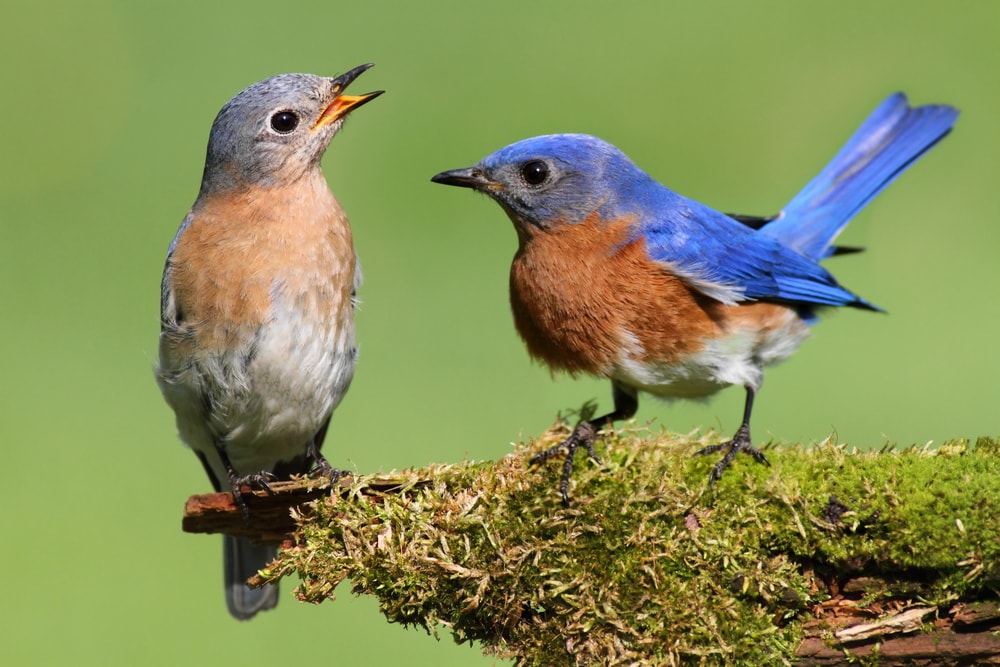The Hoosier State is the so-called crossroads of America and home for the staggering 422 birds of Indiana throughout the year, including 180 annual breeding species and even some surprising short-term migrants. Even though songbird numbers have decreased in Indiana it recent years, it is still an excellent place for bird watchers and nature photographers looking for residents, rarities, and birds flying over this territory while migrating during the spring and fall.
Indiana Birds
Officially, more than 420 native and migrating bird species are recorded in Indiana. The list includes 125 rare birds, ten introduced to this state, three already extinct, and three considered extirpated. You can divide these birds into three categories:
- Resident birds living here year-round
- Birds living in Indiana in spring, summer, and early autumn
- Birds that spend fall and winter here:
The pernicious invasive House Sparrow is amongst the most common birds sighted in backyards across Indiana, but vibrant native species manage to keep up nicely, with Northern Cardinals and American Goldfinches numbering amongst most common backyard Indiana birds throughout the year, though American Goldfinches may migrate in winter depending on food availability.
The Northern Cardinal is the state bird of Indiana since 1933 and also the official state bird in six other states. Other unique birds found in the Hoosier State include:
- The Black-necked Stilt, is a slender and elegant shorebird that has been sighted in Indiana despite the region being far outside of its regular range. An exciting vagrant, the Black-necked Stilt is one of Indiana’s rarest birds.
- Indigo Buntings are cheerful and beautiful with a melodious song and bright blue feathers that have earned them the nickname of “blue canaries.” Find Indigo Buntings in Indiana during the breeding season.
- Northern Saw-whet Owl, one of the tiniest owls worldwide can be found throughout the state, but is particular common in the northern regions of Indiana.
- The Snowy Owl is the largest owl in Indiana, though it isn’t a typical resident. Snowy Owls are known for “irruptions” that drive them out of their northern range and down into the middle sections of the United States. They occasionally even make it as far south as Texas! If you want to see a Snowy Owl in Indiana, keep your ear to the ground for irruptions and watch eBird for rare bird sighting news.
- The Pileated Woodpecker is the largest woodpecker in Indiana. To spot one, listen for the sound of this industrious woodpecker hammering away at trees for insects!
- Sharp-shinned Hawk is the tiniest hawk in Indiana and the smallest hawk in the United States. Indiana birdwatchers will love watching these hawks burst into motion as they dive through the sky after songbirds and other prey.
- If reports of Calliope Hummingbirds sighted in Indiana are true, then this is the smallest bird to find its way to the Hoosier State at just 3.5 inches long. I haven’t been able to verify whether this particular migrant has been found in Indiana, but rest assured, the state’s many hummingbird visitors are certainly contenders for smallest Indiana bird.
- The American Flamingo is probably the strangest and most exotic bird found in Indiana. After a storm scattered a flock of flamingos in late 2023, birders got the chance of a lifetime to spot a wild American Flamingo in Indiana’s Ohio River area.
- The Mallard is one of the most common bird species in the US and the most recognizable and the most commonly harvested duck in Indiana.
- The Peregrine Falcon is the largest falcon you can regularly see in Indiana. It is also the fastest living creature on the planet, with a developed speed of 200 mph (320 km/h) during dives.
Noteworthy Birds of Indiana
Planning a birding trip to Indiana? The below list includes some of the highlights including common Indiana birds as well as rarer entries to watch out for. Hopefully, this will help you tackle your Life List as you explore.
Red-breasted Merganser (Mergus serrator)
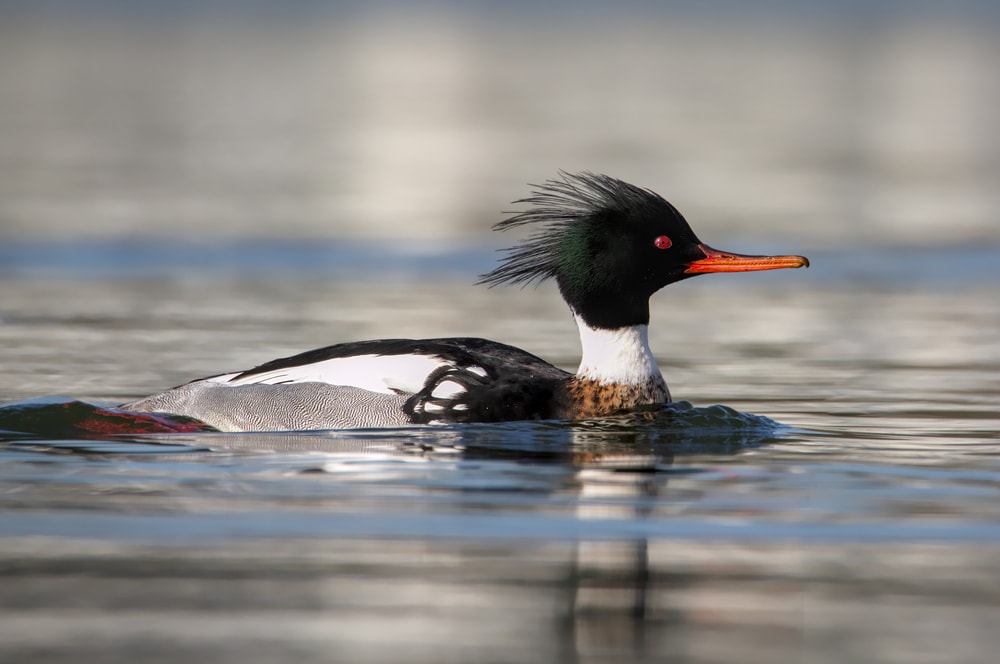
This charming, if disheveled-looking bird is a Red-breasted Merganser. They form pairs or small flocks of up to 15 birds before migrating in winter. Cornell Lab of Ornithology has reported that approximately 250,000 of these ducks live throughout the US. Even though its primary spot is around Lake Erie, you can see it in Indiana, mainly in Eagle Creek Park, at the lake coast.
Peregrine Falcon (Falco peregrinus)
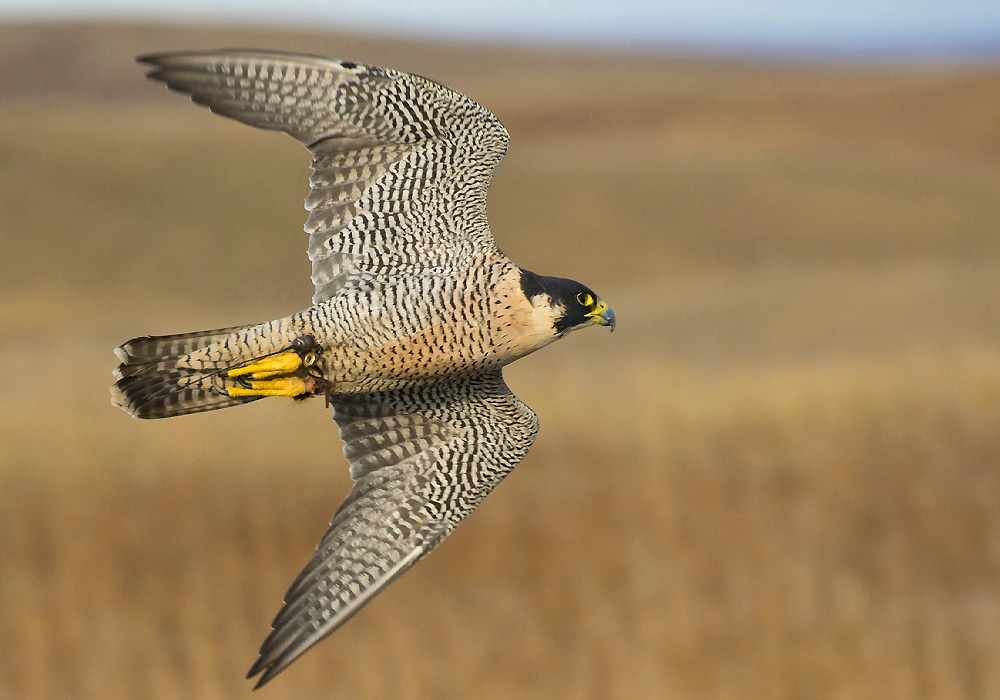
This beautiful Indiana bird is the largest falcon in this state and the fastest living creature worldwide. There is no historical data about this falcon nesting in this area, but it is a regular migratory bird along the Lake Michigan shore in the fall. Nowadays, it is reintroduced to Indiana, primarily in urban areas.
Short-eared Owl (Asio flammeus)
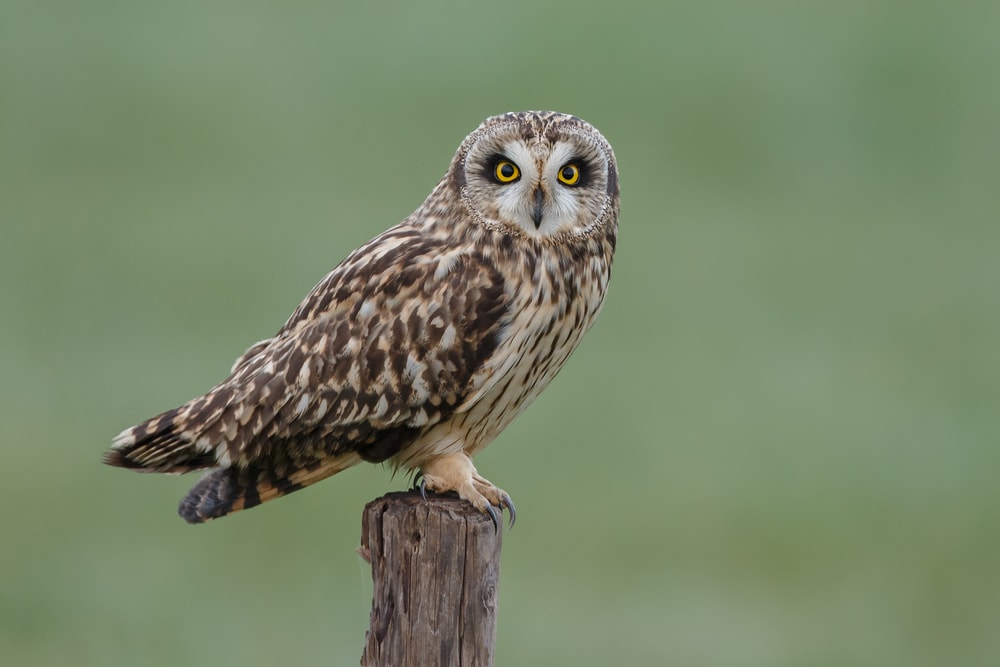
The mid-sized, flame-colored Short-eared Owl lives in grassy, open fields and builds nests on the ground. It is an erratic winter visitor in Indiana, primarily seen in the Indiana Dunes. Some may stick around throughout the year in more northern portions of the state. To spot a Short-eared Owl in these areas, look out for small loose-knit bird groups flying low over the ground.
Blue-winged Teal (Spatula discors)
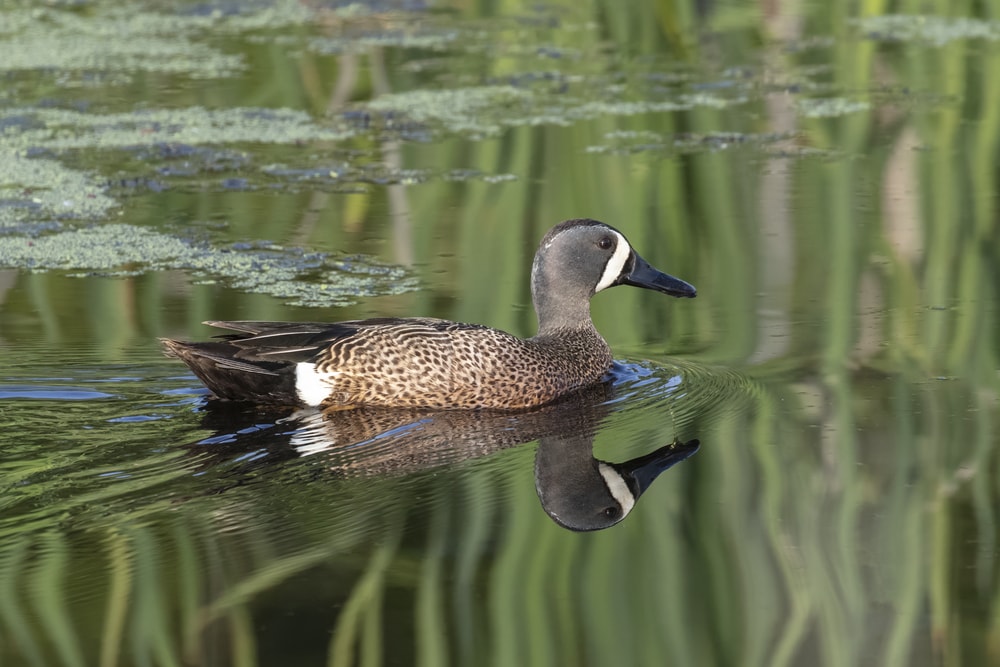
The Blue-winged Teal is one of the most familiar neotropical migrant duck species in Indiana and among the most abundant ducks in the US. Since it migrates such long distances, you can expect to see it in the Indiana Dunes and Calumet region late in spring. It will be the first species leaving the Hoosier State in summer.
Northern Saw-whet Owl (Aegolius acadicus)
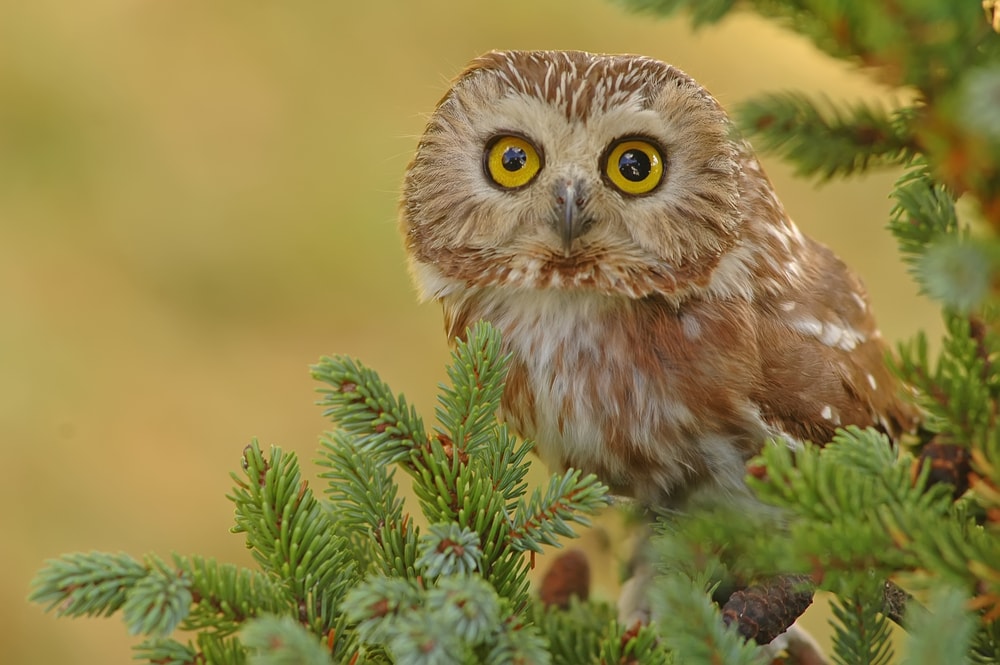
The robust population of Northern Saw-whet Owls living throughout the US are amongst the tiniest owls in the world. It is an unpredictable creature and can migrate south in winter or stay in Indiana year-round, especially in the dense coniferous forests at North. Listen for the characteristic “too-too-too” cry if you’re hoping for a Saw-whet sighting.
Cerulean Warbler (Setophaga cerulea)
Another bird that’s more often seen than heard is the Cerulean Warbler. With a high buzzy foraging call, male Cerulean Warblers aren’t hard to identify, but they tend to stick to the high treetops, so sightings can be tricky. Habitat loss has caused Cerulean Warbler populations to drop, but they are still breeding in Indiana.
Bobolink (Dolichonyx oryzivorus)
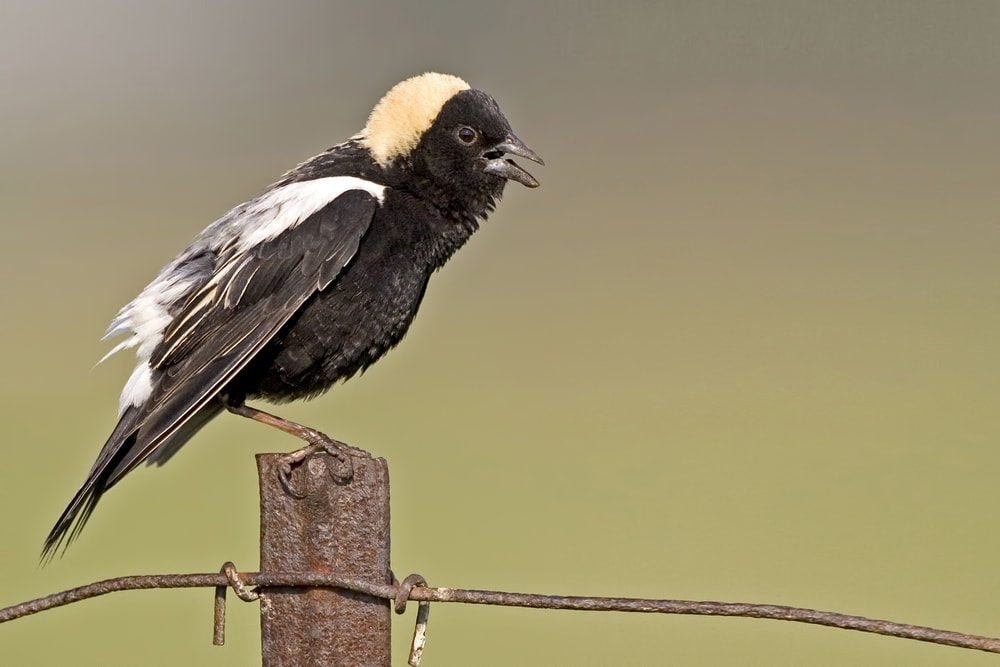
The Bobolink is a dapper and outgoing bird with a light back and dark belly that sings even while flying. You can see it in northern Indiana in the summertime, but it will only be found in southern portions of the state once winter sets in. Since 1966, Bobolink populations have declined by as much as 65%, but prairie conservation and restoration projects, like that of Indiana’s Kankakee Sands, are a light of hope for this much-loved blackbird relative.
Caspian Tern (Hydroprogne caspia)
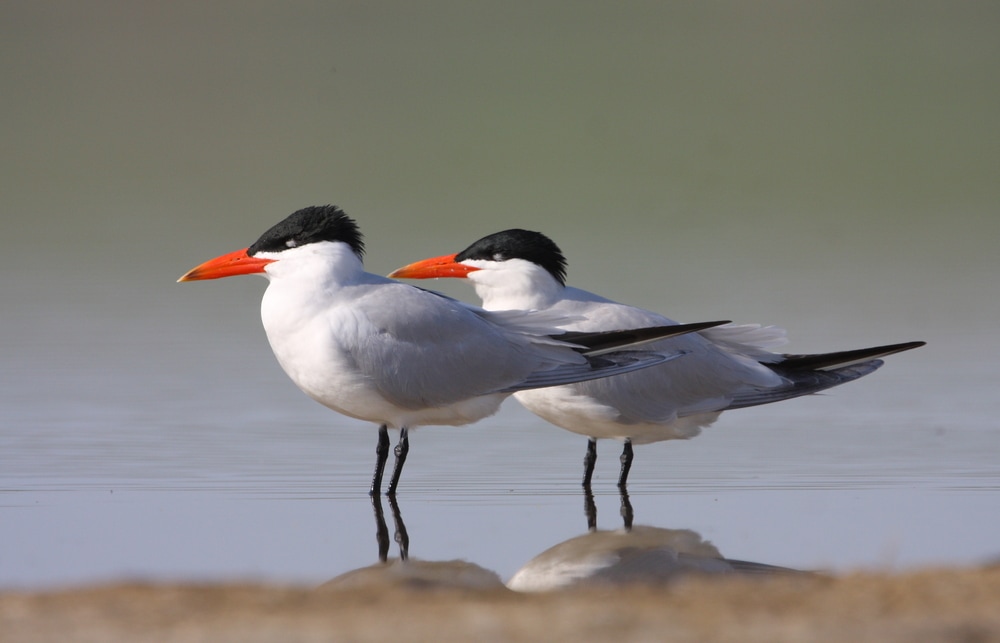
Caspian Terns are migrants that prefers saltwater wetlands and coastal bays. They nest in colonies, usually in shallow depressions on gravel islands without much vegetation. You can regularly see this beautiful wanderer flying with gulls along the Lake Michigan shore in spring and fall and during the Indiana Dunes Birding Festival.
Great Egret (Ardea alba)
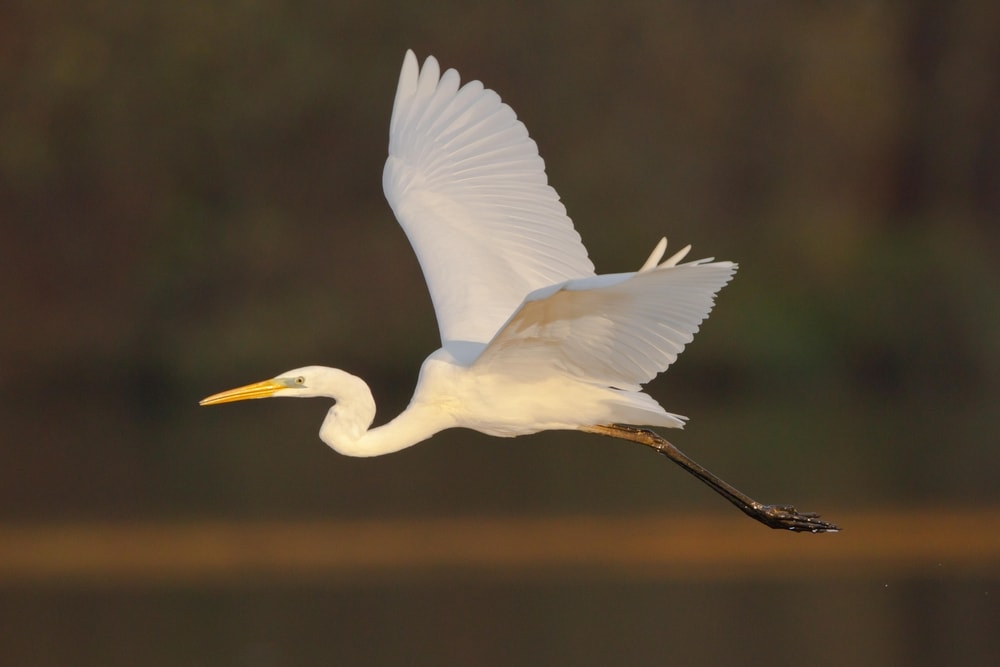
This long-necked migratory bird is a wader that nests in trees and feeds in marshes and swamps. You can occasionally see this long-legged beauty in the northern regions of Indiana. Unfortunately, its number declined drastically in the south part of the state before the Migratory Bird Protection Act was passed, because of hunting and the draining of shallow water areas.
Indigo Bunting (Passerina cyanea)
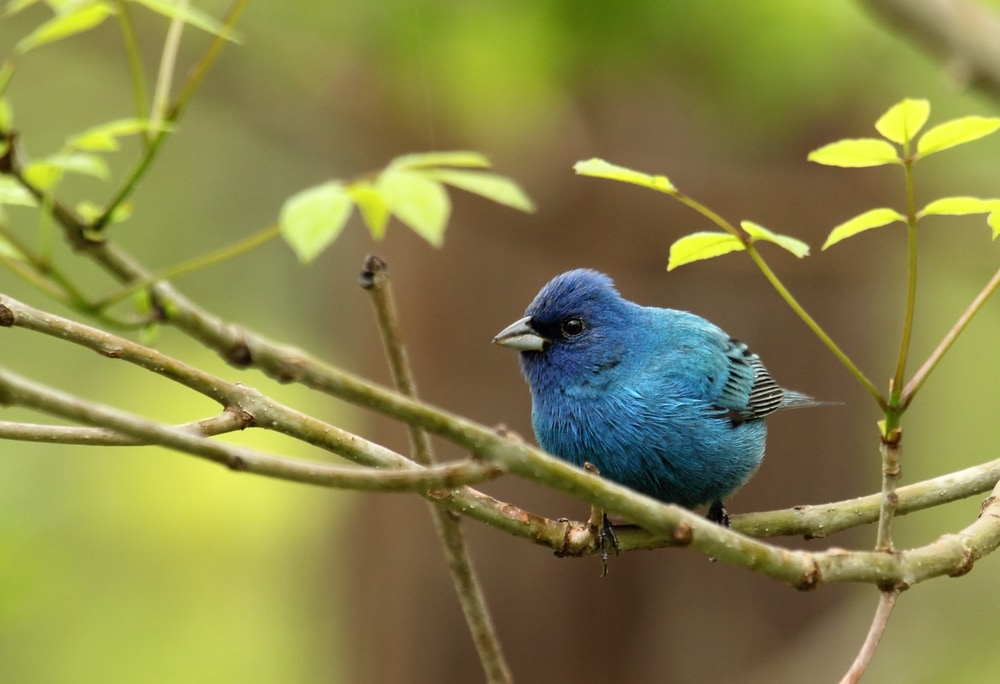
The deep velvet blue Indigo Bunting is actually black, but the light diffraction through its feathers gives it a vibrant blue appearance to the human eye. You can find this long-distance migratory bird in open woodlands. It comes to Indiana during the breeding season, goes to the south in winter, and is an a favorite songbird for many Indiana birders.
Common Birds of Indiana
A list of the most common birds in Indiana is based on eBird recorded views data. Most of them you can see in your feeders at the appropriate time of year.
Common Grackle (Quiscalus quiscula)
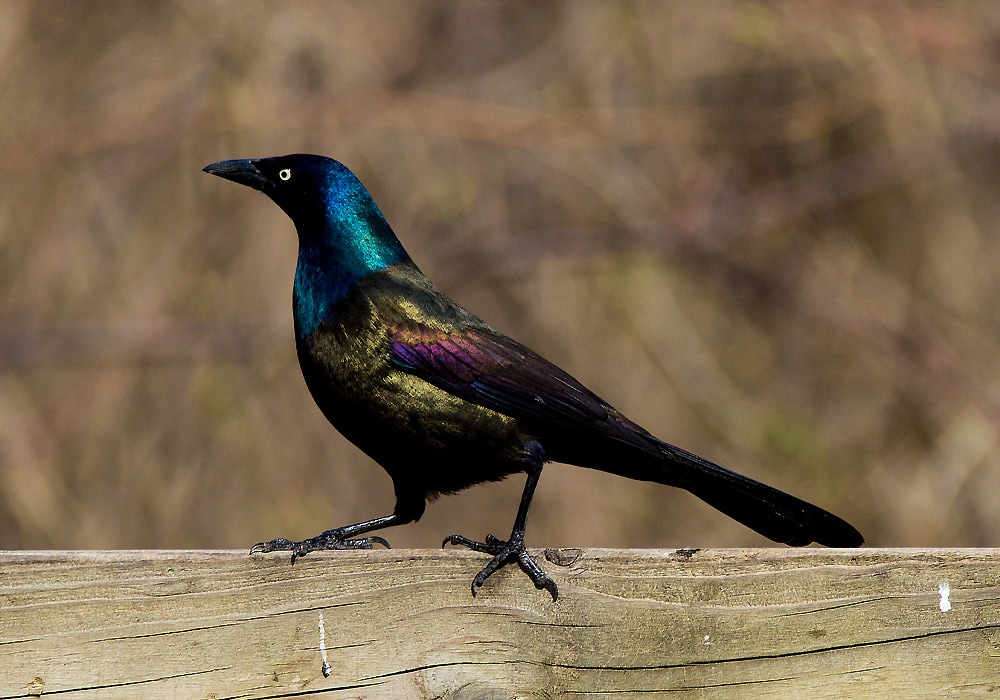
You can find Common Grackles in Indiana all year long. It is not hard to spot semi-colonies numbering about 200 bird pairs in marshes, agricultural fields, parks, and open wet woodlands. This bird nests in barns, other bird’s nests, and old woodpecker holes. It is also a pretty gregarious feeder visitor.
Red-winged Blackbird (Agelaius phoeniceus)
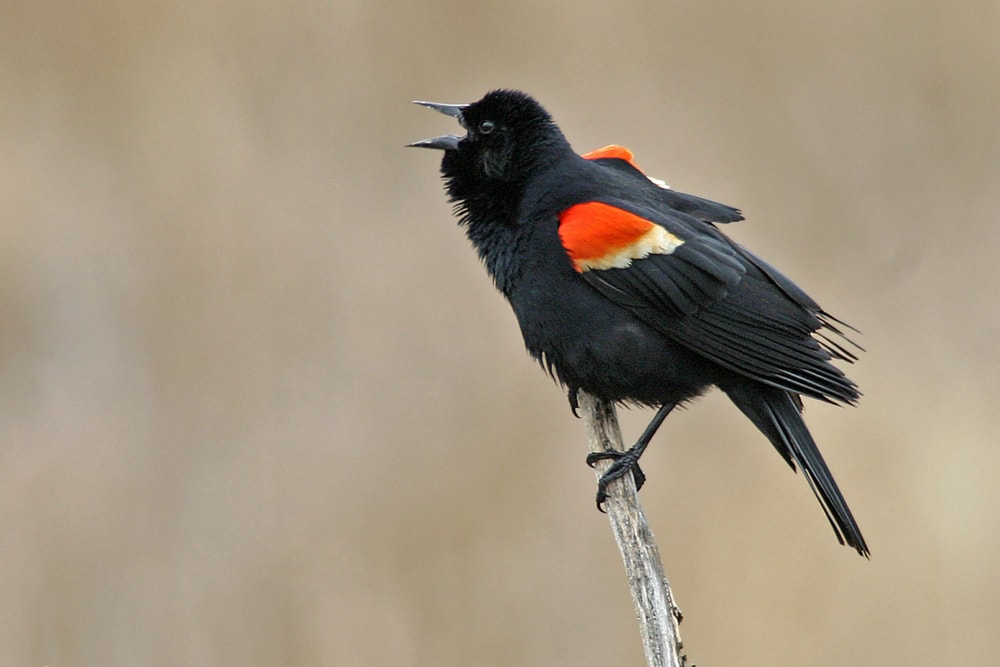
The Red-winged Blackbird is a favorite spring harbinger that spends the breeding season in wetland marshes. You can see large flocks of various blackbird species all over Indiana year-round, but the Red-winged Blackbird’s flashy red wing patches and confident song makes it stand out amongst its kind.
Snow Goose (Anser caerulescens)
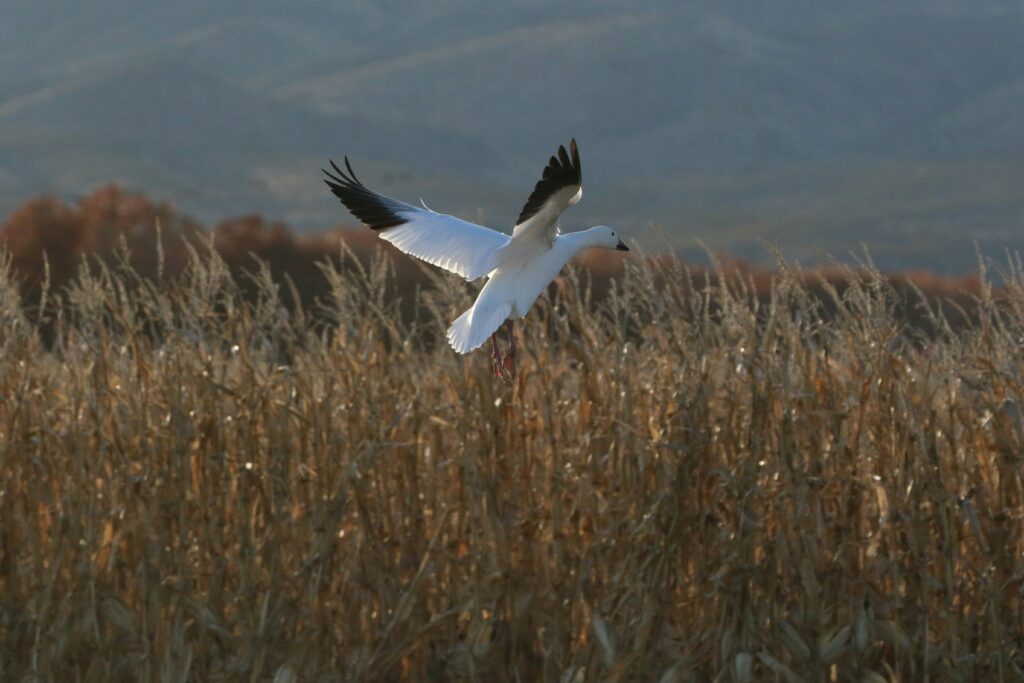
Since the Snow Goose spends its breeding season in the north, you can see these large birds in Indiana only while migrating south in fall. Look for the huge flocks of the noisiest waterfowl in the state honking next to water or in large fields. Luckily, the species have recovered well after being on the verge of extinction, and many Indiana birders are privileged to add Snow Goose sightings to their life lists.
European Starling (Sturnus vulgaris)
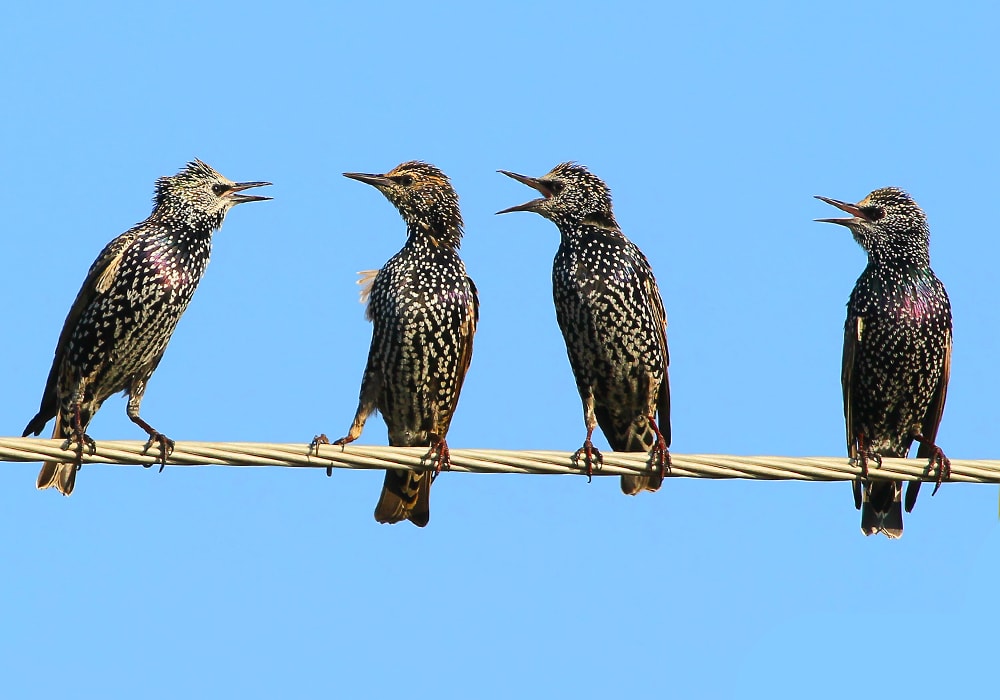
You can see European (Common) Starling all over Indiana year-round. This bird was introduced to the US in the late 1800s, and it has thrived as an invasive species ever since. Though it is beautiful, the European Starling’s presence often causes issues for native birds. They are aggressive at feeders and not at all hard to spot.
Canada Goose (Branta canadensis)
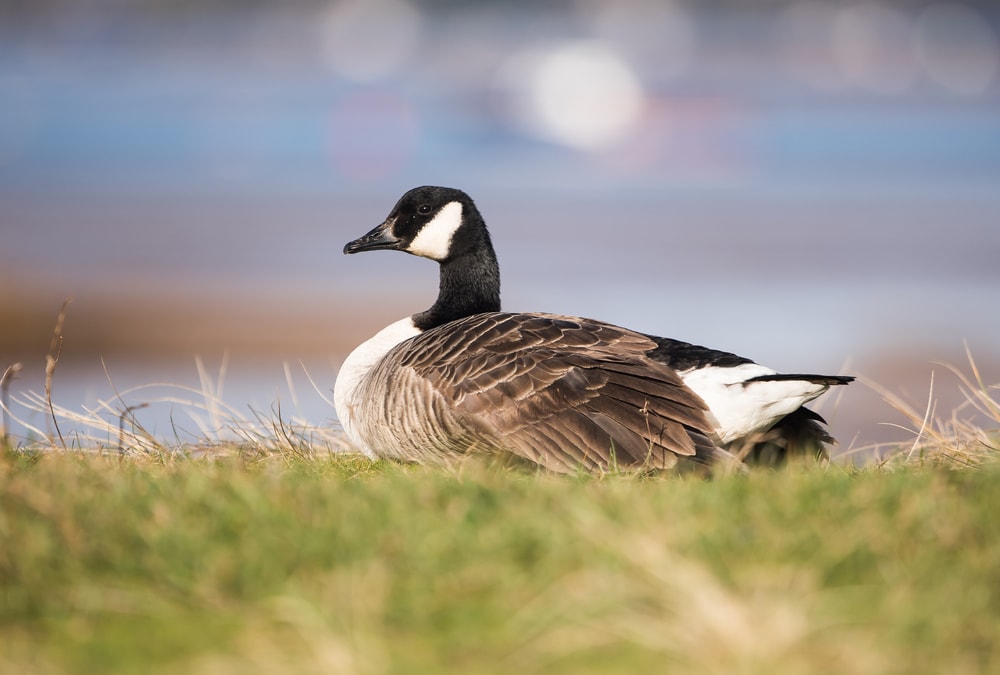
You can quickly recognize Canada Geese thanks to their V-shaped flocks during fall and spring migration. Look for Canada Geese gathering around rivers, lakes, coastal areas, and urban basins.
Purple Martin (Progne subis)
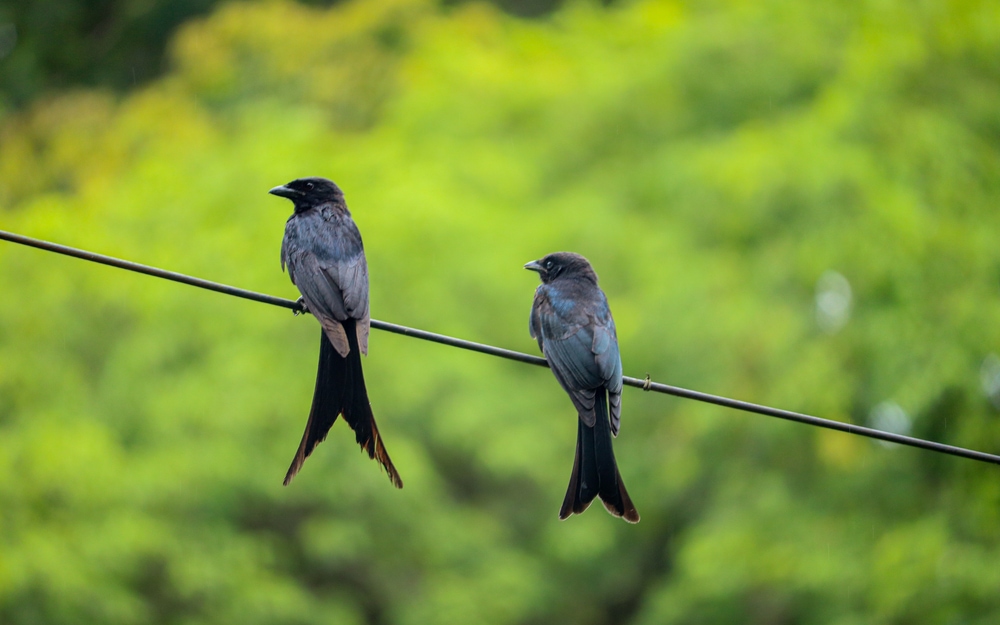
The Purple Martin is a herald of spring and one of America’s favorite bird species. You can see it in many of Indiana’s yard feeders in March after spending winter in South America, 5,000 miles (8,000 km) away. Nowadays, this bird is almost entirely dependent on human-provided housing, so pay close attention to Purple Martin houses to get a good look at these birds.
Mallard (Anas platyrhynchos)
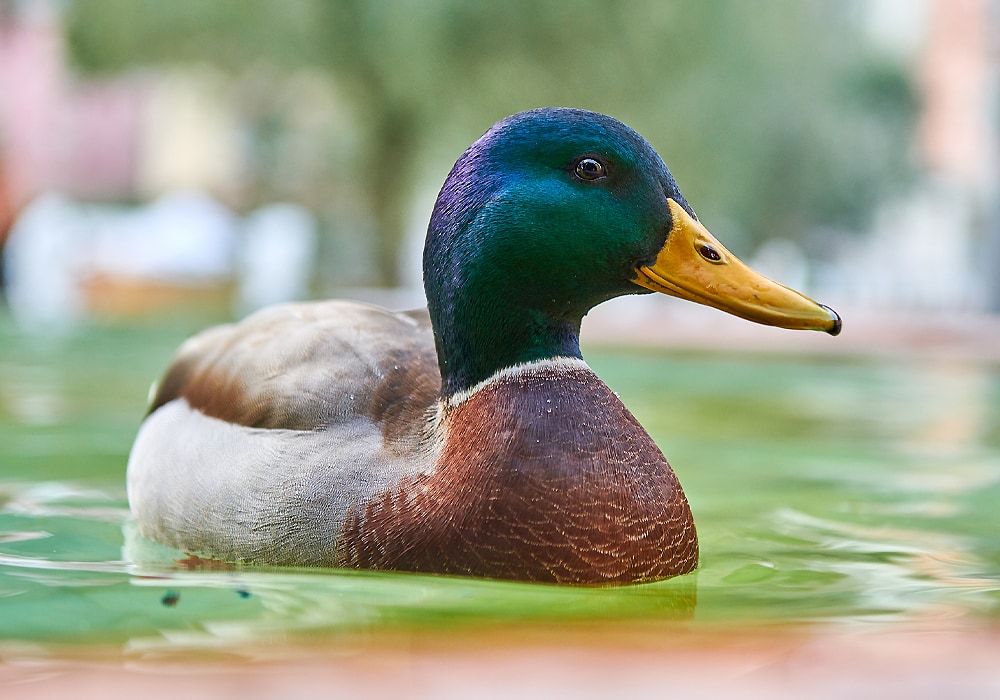
Thee Mallard is one of the most abundant duck species worldwide and is a common sight at habitats like marshes, lakes, rivers, and wooded swamps. Ornithologists disagree if feral populations are permanent residents or migratory species. You can find them across Indiana, next to swimming pools, retention ponds, and artificial, human-built structures.
Ring-billed Gull (Larus delawarensis)
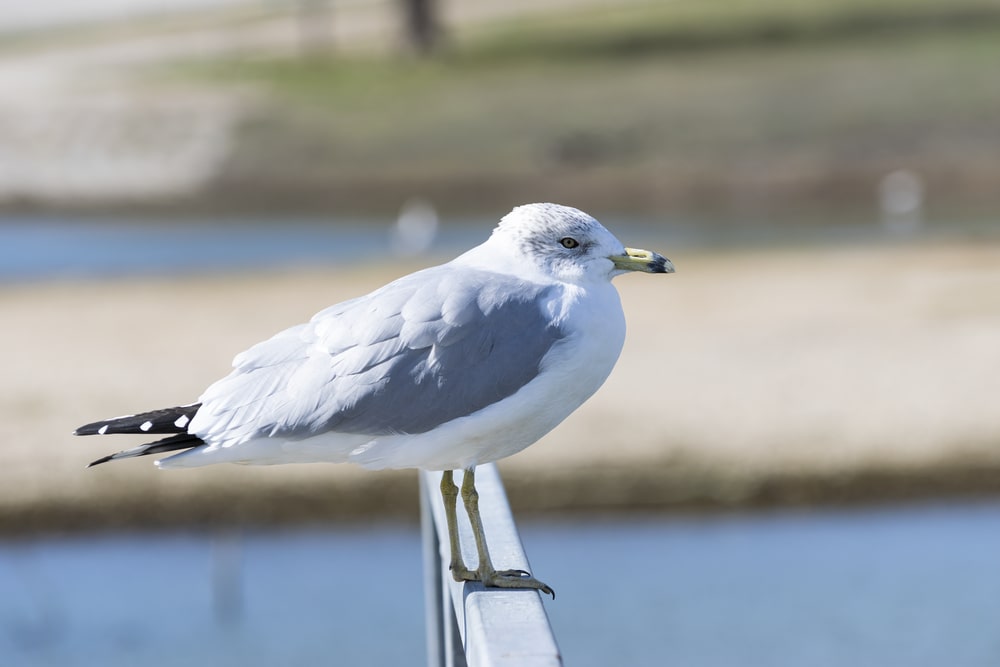
Ring-billed Gulls are migratory birds of southern Indiana. You can find them around ponds, lakes, and urban and coastal areas. This species is not rare throughout the Hoosier State, but it prefers habitats like Turtle Creek Reservoir and Bloomington’s Lake Monroe. Since it is a medium-distance migrant, it won’t go far away from the Great Lakes.
Sandhill Crane (Antigone canadensis)
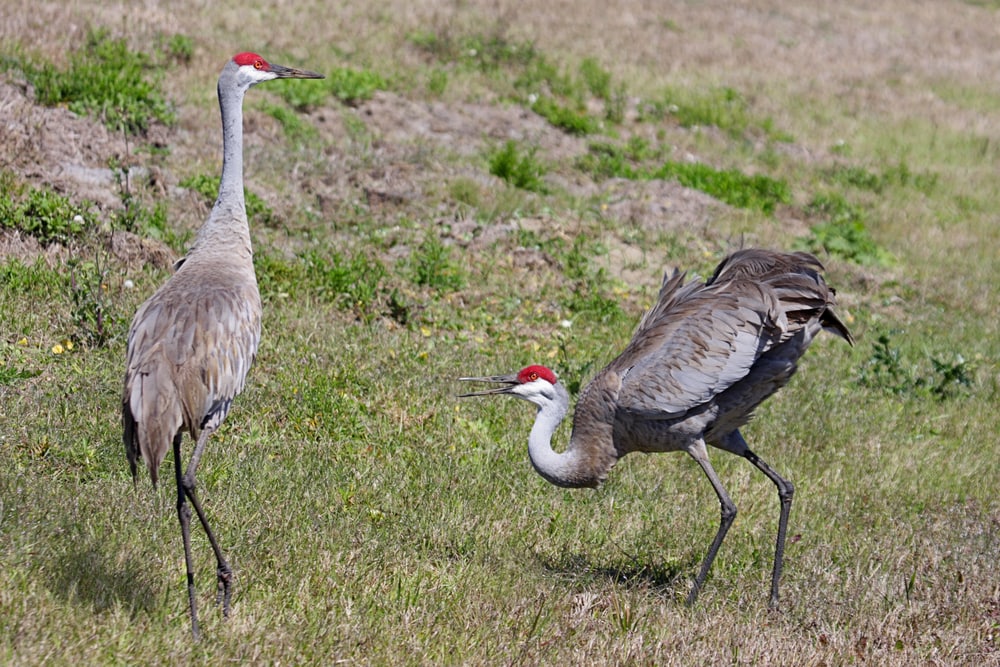
Tall and elegant Sandhill Cranes are impressive wild birds in Indiana. They stopped nesting in the US after wetlands in the North had drained. Most of them migrate to Canada, but some choose partners in northern parts of Indiana and stay. You can see approximately 20,000 birds in the Jasper-Pulaski State Fish & Wildlife Area in November.
Northern Pintail (Anas acuta)
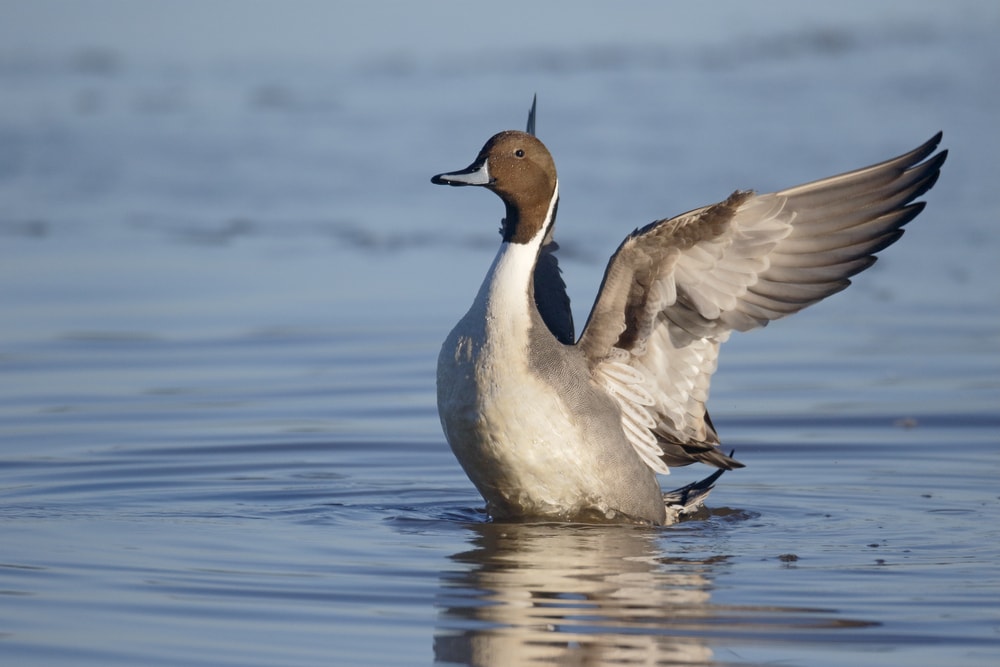
The Northern Pintail is one of the first ducks that migrate through Indiana north in spring and south in autumn. This species chooses coastal wintering grounds, agricultural areas, and shallow estuaries. Look out for Northern Pintails it in wetland habitats and wildlife refuges by following the male’s unique train whistle-like call.
Indiana Landscape and Birding Seasons
Given the topography, you can divide Indiana into three regions:
North region – It is mostly flat land with numerous small lakes, marshes, and tall-grass prairie. The 40 miles (64 km) long shoreline along Lake Michigan is a kingdom for rarities like scoters, kittiwakes, and jaegers.
Central region – It is almost completely flat with deciduous forests and the restored Limberlost swamp. The expansive city park, Eagle Creek Park, is a real hotspot with 270 bird species spotted over the years.
South region – It is a rugged region with Hoosier National Forest and three National Wildlife Refuges.
Once spring comes, the first Indiana birds that springtime birders often report seeing are American Robins singing and courting in the countryside, marshes, and near the lakeshores. Then come migrating ducks, Canada Geese, and Mallards.
While Red-tailed Hawks enjoy the first sunny days, Tree Sparrows and Dark-eyed Junco disappear from feeders after spending the winter in Indiana.
Summer is time for young birds to start their lives, making this time of year ideal for Indiana birding. You can enjoy Barn Swallows and starlings flocks flying above the countryside while goldfinches begin to nest.
Ducks start leaving the state in October, and this is an excellent period to visit Dunes and look for rarities like Iceland gull and Eurasian Wigeon. Finally, you can enjoy birds native to Indiana during winter and solitary winter wanderers. If you are lucky, this is the time to keep your eyes peeled for Snowy Owl irruptions.
Indiana Birding Hotspots
Although you can find numerous bird species all over Indiana, the most popular hotspots are located along a 40 miles (64 km) long Lake Michigan shoreline.
Indiana Dunes SP
Indiana Dunes is the ultimate area for watching birds of Northwest Indiana, with over 350 species living and migrating here. Come in spring to count a hundred hawks or enjoy spectacular Sandhill Cranes migrations in fall. It is also a great place to catch a glimpse of nesting birds like Red-headed Woodpeckers, Baltimore Orioles, Red-shouldered Hawks, Prairie Warblers, and Scarlet Tanagers.
Miller Beach, Lake Street
Come here in August to scan the lake and its beach for migrating gulls, terns, and shorebirds, and the rarest of the rare Indiana birds like jaegers. Fall is an ideal period for Indiana bird identification and looking for migrating Bald Eagles, Sandhill Cranes, and neotropical species, including the Golden-winged Warbler, Wood Thrush, and Canada Warbler.
Eagle Creek Park
Eagle Creek Park is the largest city park in Indianapolis and a productive destination for over 270 Indiana birds. You can find nesting birds like Wood Ducks, American Woodcocks, and Yellow-throated Warblers after enjoying the hummingbird garden in the Ornithology Center. Sometimes, you can see the endangered Hooded Warbler. Don’t forget to keep an eye out for ducks as well!
Indiana Dunes SP – Observation (Green) Tower
A tower might seem like an unlikely birding spot, but this is the place to spot a staggering 283 noticed bird species. In fact, birders come from all over the state to birdwatch from the tower. It is the perfect spot to see Red-winged Blackbirds, Common Grackles, Brown-headed Cowbirds, and many of Indiana’s rarest birds.
Gibson Generating Station
Generating Station and the associated lake for storing wastewater have attracted about 300 bird species to its shores for decades. This place is known among birders since endangered the Least Tern is often seen here. You can also find American White Pelicans, Red-breasted Mergansers, American Coots, Double-crested Cormorants, and Green-winged Teal.
Cane Ridge WMA
Come to the south part of Indiana and visit Cane Ridge to see shorebirds, Bald Eagles, waterfowl, and the only two Least Tern nesting colonies east of Mississippi. Look for rare Black-necked Stilts and Wilson’s Phalaropes, and the first recorded Mountain Bluebird, Sharp-tailed Sandpiper, and Northern Wheatear in the state. Snowy Egrets and Cattle Egrets are also discovered here in winter.
Willow Slough FWA
A combination of woodland, prairie, and marsh makes Willow Slough an ideal area to hear many Indiana bird calls. Look for the rare Smith’s longspur, Ross’s Goose, Yellow-headed Blackbird, and Black Rail. It is also an excellent location to enjoy Bald Eagle and Osprey flights. Be aware that some areas are closed during the hunting season.
Lakefront Park and Sanctuary, Hammond
This tiny isolated patch of greenery between Lake Michigan and the urban area is a migrant trap. Come here in spring and fall to see up to 250 bird species resting and feeding during migrating. You can also see Common Yellowthroats, Magnolia Warblers, American Redstarts, and Rose-breasted Grosbeaks!
Summit Lake SP
Summit Lake is located not far from New Castle and is one of the best places to watch Indiana water birds. Birders usually occupy vantage points with excellent views of numerous scoters, terns, geese, gulls, and ducks, including the uncommon Long-tailed Duck. Sometimes, it is possible to spot a pair of nesting Bald Eagles and migrating pelicans.
Celery Bog Nature Area
Celery Bog is a hotspot for 258 bird species, including 25 shorebirds. There are numerous Indiana winter birds to be found here, like breeding Wood Ducks, Great Blue Herons and Pied-billed Grebes, and migratory Bald Eagles and Osprey. Local forest near the wetlands are excellent for nestling Rose-breasted Grosbeaks, Baltimore Orioles, and Indigo Buntings.
Indiana Field Guides
Any bird lover needs a field guide, whether you’re a smartphone app fan or an old-fashioned paper-and-ink loyalist. If you don’t have an internet-enabled device or want to explore remote areas without stressing cell coverage, an inexpensive physical field guide can be a big help. Choose the best birds of Indiana field guide fir you, and head on out to explore!
Birds of Indiana Field Guide
Try Stan Tekiela’s Birds of Indiana for help learning to identify birds and making birding even more enjoyable. The author makes bird identification simple by including detailed photographs, fact-filled information, and range maps. With this guide in hand, you’ll effortlessly recognize 112 described bird species in no time at all.
Midwestern Birds: Backyard Guide
If you enjoy Indiana backyard birds, you should look into Bill Thompson’s practical guidebook. It features the 55 most common backyard birds in the 15 Midwestern states. This book includes high-quality color photos, bird physical descriptions, bird calls, exciting stories, and valuable feeding and nesting information. Focusing on common backyard birds will help you master the basics of bird identification.
Indiana Bird Watching
Bill Thompson also published this convenient state-specific book that will help you identify the birds of Indiana. It is a helpful book for beginners and intermediate birders thanks to its detailed descriptions and range maps.
Indiana Bird Checklist
According to Avibase (Worlds Bird Checklist), you can find as many as 437 different types of birds in Indiana, including 19 introduced species. When you are a birder planning to visit this state or live here, you should take this handy bird checklist before starting birding. You can also download the complete, up-to-date list of all bird species in this state.
Download FREE Indiana Bird Checklist PDF
Click here for an overview of Indiana Birds
Specific Bird Species
With this huge list of birds, including 125 classed as rare and ten introduced, Indiana is an excellent area for birding and offers something for just about everyone.
Hummingbirds in Indiana
In Indiana, you can typically find six of these small nectar-loving garden birds. Migrating Ruby-throated Hummingbird males come at the beginning of April, followed by females and offspring approximately two weeks later. You can sometimes see Rufous Hummingbirds from November to January, and migrating hummers are easy to attract to hummingbird feeders.
Owls in Indiana
Officially, it is recorded that eight of these nocturnal birds of prey are found in Indiana, and you only need to check their range maps to determine where to see each of them. Great Horned Owls, Eastern Screech-Owls, and Barred Owls are found all over the state year-round, while Snowy Owls are rare and prefer the shores of Lake Michigan during irruption years.
Woodpeckers in Indiana
Roughly 240 woodpecker species exist worldwide and 22 of these are found in the US. among them, eight are officially recorded in this state. Most of these Indiana woodpeckers are residents that hang around all year-round. The Pileated Woodpecker is the largest Indiana woodpecker, though it’s hard to compete with the Red-headed Woodpecker and the Northern Flicker when it comes to beauty. You can find them in residential areas, forests, and along rivers.
Finches in Indiana
You can expect to reliably spot at least eight Indiana finches of the eleven recorded. Purple Finches spend their time in coniferous forests, but you can sometimes see them in your backyard along with American Goldfinches that enjoy visiting feeders. The House Finch is a year-round state resident, but it is most abundant in residential areas in the wintertime.
Bluebirds in Indiana
It isn’t hard to spot bluebirds in Indiana, as long as you’re looking for the Eastern Bluebird. The Mountain Bluebird is quite rare and many experts consider only Eastern Bluebirds to live in this state consistently. Eastern Bluebirds are found mostly in open areas, but they also readily use human-made nesting boxes. They are medium-distance migrants that prefers spending winters in the South.
Hawks of Indiana
You can find eight types of these sharp-eyed Indiana birds of prey in all sorts of habitats, but it is sometimes quite hard to differentiate them. Red-tailed Hawks and Cooper’s Hawks are highly adaptable species, making them the most common in this state. The smallest Sharp-shinned Hawk is incredibly athletic, and you will enjoy its acrobatic flights.
Falcons in Indiana
Technically, six falcon species are recorded in Indiana, but you can commonly see only three. Luckily, you can find these three almost anywhere. While American Kestrel lives in the state year-round, Peregrine Falcons and Merlins are migratory species.
Ducks in Indiana
Forty-one ducks, waterfowl, and geese are seen statewide during the Indiana waterfowl season, including migratory Mallards that live in wooded swamps, marshes, and next to lakes and rivers. Look for Northern Pintails in wetland habitats. It only migrates at night and can fly non-stop up to 1,800 miles (2,890 km) at approximate speeds of 48 mph (77 km/h).
Wrens in Indiana
Seven wren species are sometimes sighted in the Hoosier State, but only five are common. Even though Marsh Wrens are common breeding birds of northern Indiana, their marsh-dwelling lifestyle can make them difficult to sight. House Wrens are the most common breeding wrens, and are often seen in backyards.
Sparrows in Indiana
It is possible to see two Old World sparrow species and 26 New World sparrow species in Indiana. The most common is the invasive House Sparrow. These are regular feeder visitors. Birders in search of a challenge often try to spot the Henslow’s Sparrow singing throughout spring and summer in the Big Oaks National Wildlife Refuge.
FAQ
What is the most common bird in Indiana?
The most common Indiana birds throughout the year are House Sparrows, Northern Cardinals, Blue Jays, Downy Woodpeckers, American Robins, Dark-eyed Juncos, American Goldfinches, and Mourning Doves.
What types of birds are in Indiana?
Since ornithologists and birders detected approximately 800 bird species throughout the US, Indiana’s 400+ birds make it a hotspot for all kinds of birding. Although it is a landlocked state, its proximity to the Great Lakes means that even shorebirds aren’t off limits.
What is the rarest bird in Indiana?
Even though the easily identifiable Black-necked Stilt is quite common in most West and Southwest states, it is a rare and unusual sighting in Indiana, surpassed, perhaps, by the very rare American Flamingo sightings that occurred in late 2023.
How many species of birds are in Indiana?
The list of Indiana birds covers 437 species, including 180 annual breeding species, 125 rare, ten introduced, and three extirpated and extinct bird species each.
Do Ospreys live in Indiana?
Yes, there are at least 100 osprey nests found in Indiana in 2022, thanks to DFW wildlife biologists raising 96 young birds at four locations from 2003 to 2006.
Do Magpies live in Indiana?
Most Magpies live in the western half of the US, but you can find black and white noisy American Magpies (Black-billed Magpie) in Indiana as well.

